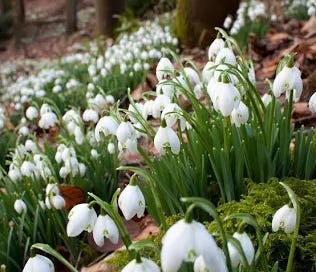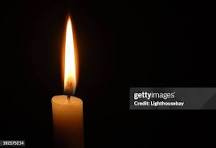I am writing this on February 2nd. Candlemas.
This date falls half way between the winter solstice of December 21st and the Spring Equinox, March 20th, this year. Light at the end of the tunnel. In the Christian tradition, it’s the Presentation of Jesus at the Temple. If you are a Celtic pagan, it’s Imbolc - the belly of the Mother. Or maybe you prefer Groundhog Day. I, for one, ran back indoors this morning, not because I saw my own shadow, but because it was below freezing.
I love candles in my home. I usually light them on winter morning, when I am up early, and it’s still dark, and I don’t want the attention- seeking of electric light. My mind is still in its liminal state after waking - part awake part dream. I like to sit with it for a while, before the demands of the day, so that I can know myself a little better.
So that I can find hope.
Our world-self is all electric light; full-on, productive, mega-watts of busyness. I am dedicated to the day, and my obligations, and to-do list. But I need a bit of time out of time too. In my creative work, I can sit and stare and think, and I have made a life where I can do that work well. Yet, I can’t manage without time to unthink. My mind in purr-mode has no obligation but to be. That happens best for me early morning, with a candle, and maybe a cat, watching shadows. Candlelight distorts shapes, so that the familiar is not, and I notice the space underneath an upright chair, or the weird cut-out of the kettle against the wall, and my hand lit, and my body dark. Then I open the door and go into the yard, with my candle, and in the company of fading stars, and the beginning of birdsong. The well-known garden looks different. I can hear my breathing. Something scutters. I am not doing. I am not sure I am even being. Only, I am present.
Snowdrops are the first flowers to mark the beginning of the end of a British winter. An old-fashioned name for them is Candlebells, - their first flowering is usually now, at Candlemass. I have thousands in my garden, because each year, when they die down, and are in the green, I split and transplant clumps of them. This is more than gardening. It’s a way of keeping faith with the future. I am hoping I will see another spring. Hoping there will be another spring. Climate change is blurring the seasons. I long ago left the city so that I could be closer to the natural world. Not as an observer. As a working part. At this time of year, in the northern hemisphere, when we know spring is coming, something in us rises to meet it. For our ancestors, before the industrial revolution, spring meant life in a very real sense. Food. Warmth. Hope.
Hope is more than expectation or anticipation. Hope is not a utility-word at all. Sure, we can hope the train will come, or that our daughter will pass her exams, but when we hope for what’s vital to us, there’s longing in there, a kind of sympathetic magic that the strength of our desire will spur the outcome. When our ancestors lit bonfires at the winter solstice and candles in February, they weren’t only marking a date, they were participating in the outworking of their desire - that the sun would return, that spring would surely come. And we, in our wisdom, can say, but of course the sun returns and spring comes, fires lit or not, candles or not. And that’s right. What’s not right is when we get to a point where we believe that we, as individuals, as communities, can have no impact on the degraded state of the world right now.
Hoping things will change requires active participation. And if folks laugh and say it makes no difference, let them laugh, and carry on with your hope. Hope is not day-dreaming. Hope is not passive. We risk ourselves. Maybe we make fools of ourselves. Hope is not certainty. It is not ‘I want’. It’s bigger than that. And when our unscientific ancestors built their fires and lit their candles to encourage the sun and the light, sure, they had no effect on nature, but a drastic effect on themselves. They had found a ritual to keep them going. They had found hope.
People can live without plenty of things. People can live without love. No-one can live without hope.
To keep hope alive requires effort. We think of effort as outward-facing activity, and in a secular society, it’s hard to talk about spiritual effort - because that’s directed inwards. I don’t mean self-improvement, or self-help, or any of the frantic western responses to disquiet. I mean quiet. Just that. Without any distractions. And so it is easier, early or late, and not an indulgence at all, to sit with yourself, or stand in your yard, or whatever it is you need to do, to be calm, and then to connect, and to notice what arises. This morning, early, when the light opened the garden, the first thing I saw were the snowdrops, luminous soft white, like the moon had dropped something.
I went in to make coffee, feed the cats, call a friend in difficulty, all the beginnings of the day. I blew out the candle. It had done its work - a ritual to help me do mine.





Every year for many years during the dark season I’ve reread your lovely piece about the holy dark and cooking mushrooms and sipping red wine and defecting from the fluorescent lit neurosis of modernity and inhabiting our wintering. This beautiful piece feels like the imbolc symmetrical piece, about hope and dedication to emergent life and I’m so grateful to be able to find your words here today. Thank you for clearing a path for sanity and for my own dedicated writing life. Grateful. Deeply. 🙏🏼
What gives me hope is knowing that for all of us, including those who wish us harm, things never go quite according to plan. In their failures, which will be many, there is always an opening to do otherwise and differently. In the dark, look for those openings that let in the light, and when you find one put your finger in it and twist it bigger. Hope in action.